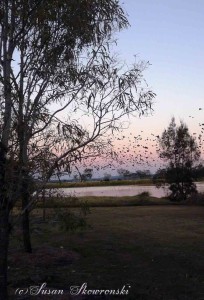By Susan Skowronski
Rose pink light
at the end of the day
drains away colour
softens the landscape
creates silhouettes
and darkening shadows.
She oaks whisper
in the slight evening breeze
invite home coming birds
to seek shelter and roost,
bring peace to the lakeside
and welcome the night.
The stillness of gloaming –
a moment to pause
give thanks for the day
and labours’ rewards.
Serenity creeps in
grants farmlands their rest
What is THE GLOAMING? – http://en.wikipedia.org/wiki/Gloaming
Gloaming, or twilight, the time after sunset and before dark. The illumination that is produced by sunlight scattering in the upper atmosphere, illuminating the lower atmosphere when the Sun itself is not directly visible because it is below the horizon, so that the surface of the Earth is neither completely lit nor completely dark. The word “twilight” is also used to denote the periods of time when this illumination occurs.
The further the Sun is below the horizon, the dimmer the twilight (other things such as atmospheric conditions being equal). When the Sun reaches 18 degrees below the horizon, twilight’s brightness is nearly zero. Evening twilight ends and night begins. When the Sun again reaches 18 degrees below the horizon, night ends and morning twilight begins. Owing to its distinctive quality, primarily the absence of shadows and the appearance of objects silhouetted against the bright sky, twilight has long been popular with photographers, who refer to it as ‘sweet light’, and painters, who refer to it as the blue hour, after the French expression l’heure bleue.

Leave a Reply